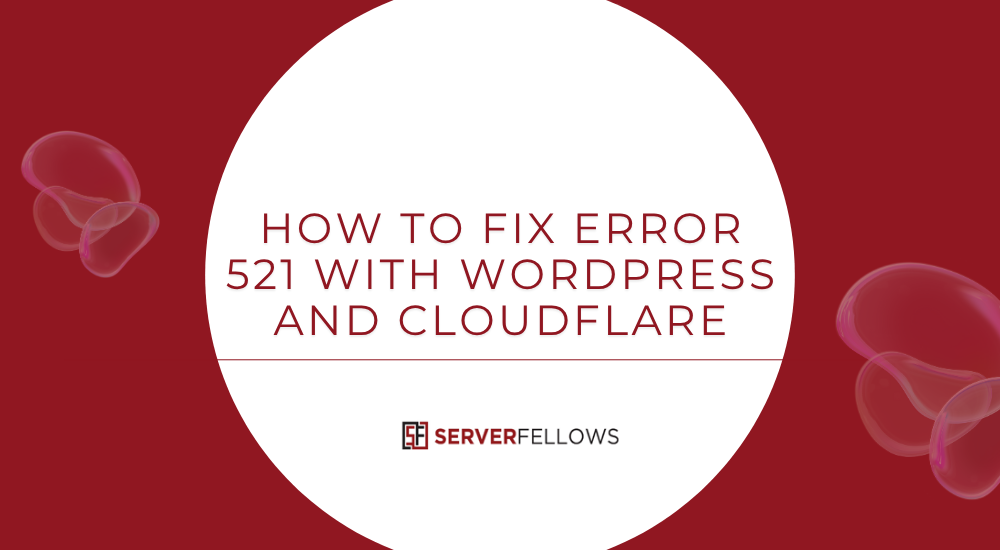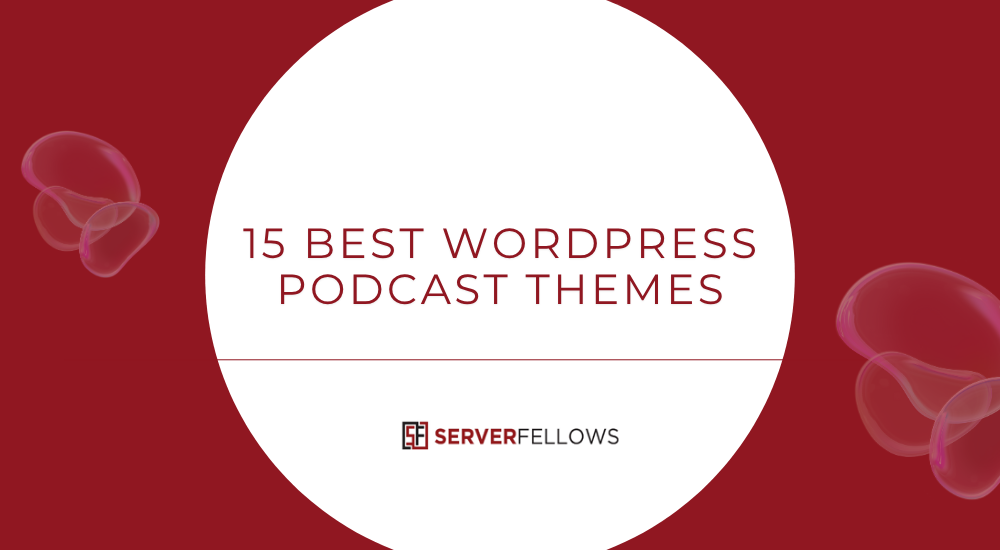
How to Fix Error 521 With WordPress and Cloudflare
If you’ve ever seen Error 521 while using WordPress with Cloudflare, it means Cloudflare can’t reach your origin server. This connection failure stops your site from loading and can negatively affect user trust and SEO performance. The good news? It’s fixable.
This guide explains how to fix Error 521 with WordPress and Cloudflare, covering causes, diagnostics, and practical solutions to restore full availability.
What Error 521 Means
Error 521 indicates that Cloudflare tried connecting to your WordPress hosting server but received a “connection refused” response. This usually happens when your origin web server is offline, overloaded, or blocking Cloudflare’s IP ranges.
In short, the message “Web server is down” doesn’t always mean your entire server crashed—it might just be refusing Cloudflare’s requests.
Quick Summary of Error 521 Causes:
- Server down or not responding on ports 80/443
- Incorrect DNS configuration
- Firewall blocking Cloudflare IPs
- SSL/TLS mismatch
- PHP-FPM or web server crash
- Security plugin restrictions
- Misconfigured redirects or .htaccess rules
At Serverfellows.com, we often see Error 521 cases where simple SSL or DNS misconfigurations cause unnecessary downtime. Let’s break down how to fix it.
Step 1: Check If the Origin Server Is Online
Before adjusting Cloudflare or WordPress settings, confirm that your hosting server is running properly.
-
Ping your origin IP address:
Run aping yourserveripcommand or use online uptime tools to verify response. -
Use cURL for direct testing:
curl -I http://yourdomain.com --resolve yourdomain.com:80:your.server.ip
If the server replies with a valid status code (200 OK), it’s reachable.
-
Check services:
Ensure web server (Apache/Nginx) and PHP-FPM processes are active. Restart them if necessary. -
Inspect hosting dashboard:
Sometimes hosting environments go through maintenance—confirm uptime before deeper troubleshooting.
If the server isn’t responding, no amount of Cloudflare tweaking will help. Fix the origin first.
Step 2: Verify DNS Settings in Cloudflare
DNS misconfigurations are a leading cause of Error 521.
- Go to Cloudflare Dashboard → DNS tab.
- Ensure A or AAAA records point to your actual public server IP.
- Avoid pointing to internal or outdated IPs.
- Make sure the orange cloud (proxy mode) is active for the correct records.
- If using multiple servers or staging environments, confirm DNS propagation.
Tip: Tools like DNSChecker.org help verify global DNS updates.
If your DNS records are correct and the server still refuses Cloudflare, move on to firewall and port checks.
Step 3: Whitelist Cloudflare IP Ranges in Your Firewall
Firewalls often block Cloudflare unknowingly, leading to 521 errors.
You must allow all Cloudflare IPs through your hosting provider’s firewall and any WordPress security plugins.
List of Cloudflare IPs:
https://www.cloudflare.com/ips/
On your server:
sudo ufw allow from 173.245.48.0/20
sudo ufw allow from 103.21.244.0/22
sudo ufw allow from 103.22.200.0/22If using plugins like Wordfence or Sucuri, add Cloudflare IPs under the “Allowlist” section.
At Serverfellows.com, our managed hosting environments already have Cloudflare IPs pre-whitelisted, saving users hours of configuration.
Step 4: Confirm Ports 80 and 443 Are Open
Cloudflare only communicates over specific ports—most importantly 80 (HTTP) and 443 (HTTPS).
To verify:
sudo ufw statusor
netstat -tulpn | grep 443If these ports are closed, Cloudflare can’t reach your WordPress site. Ensure both are open in:
- OS firewall
- Web host control panel (e.g., cPanel, Plesk, etc.)
- Any upstream firewalls or proxies
Step 5: Align SSL/TLS Settings Between WordPress and Cloudflare
A major cause of Error 521 involves SSL handshake failures.
Check the Cloudflare SSL/TLS mode:
- Off: Not recommended
- Flexible: Encrypts only between the browser and Cloudflare
- Full: Encrypts end-to-end (Cloudflare to server)
- Full (Strict): Encrypts end-to-end with verified certificates
For WordPress sites, Full (Strict) offers the best security and compatibility—provided your server has a valid certificate.
Ensure:
- Your certificate is valid and not expired
- The domain name matches the certificate CN
- Auto-renew is enabled
You can issue a free Origin Certificate from Cloudflare and install it on your hosting server to secure Cloudflare–server connections.
Step 6: Install a Cloudflare Origin Certificate (Optional but Recommended)
Cloudflare Origin Certificates secure communication between Cloudflare and your server, minimizing 521 errors due to SSL mismatches.
How to Set It Up:
- In Cloudflare, go to SSL/TLS → Origin Server → Create Certificate.
- Copy the certificate and private key to your server.
- Save them under:
/etc/ssl/certs/origin.pem
/etc/ssl/private/origin.key- Configure your Nginx or Apache virtual host to use these files.
- Restart the web server and test using:
curl -Iv https://yourdomain.com
Once successful, Cloudflare will recognize the secure origin and eliminate 521 handshake errors.
If your hosting provider doesn’t allow custom SSL installs, consider moving to flexible managed WordPress hosting like Serverfellows.com that supports full Cloudflare integration.
Step 7: Check WordPress Configuration and Plugins
Sometimes the cause isn’t Cloudflare—it’s WordPress itself.
-
Deactivate plugins temporarily:
Security, cache, or redirect plugins may block Cloudflare requests. -
Switch to default theme:
A broken theme function could disrupt headers or HTTPS handling. -
Inspect
.htaccess:
Look for “Deny from all,” IP restrictions, or forced HTTPS rules that exclude Cloudflare IPs. -
Review Maintenance Mode:
Some maintenance plugins or coming-soon pages return “503” or “403” errors that Cloudflare interprets as 521.
Testing your site directly (bypassing Cloudflare) helps isolate whether WordPress or the proxy layer is responsible.
Step 8: Review Server Logs for Clues
Your logs are your best friend when tracking 521 errors.
Check:
- Apache/Nginx error logs for connection refusals
- PHP-FPM logs for crashes
- Firewall logs for denied Cloudflare IPs
- Cloudflare dashboard for Ray IDs and request details
If you spot frequent TCP resets or connection timeouts, your server may be overloaded. Scale up resources or enable caching to reduce load.
Step 9: Monitor and Prevent Future 521 Errors
Once you’ve fixed the issue, prevent it from recurring by setting up active monitoring.
- Use uptime monitors (like UptimeRobot or Pingdom).
- Enable Cloudflare analytics alerts for spikes in 5xx errors.
- Monitor SSL certificate renewals automatically with scripts or cron jobs.
- Audit firewall rules every month.
A proactive approach ensures continuous uptime and maintains SEO health. Cloudflare 521 downtime signals can lower trust and impact site performance in search rankings.
If you want your hosting and security fully managed, Serverfellows.com offers performance-optimized hosting with Cloudflare pre-integration, daily backups, and SSL automation.
Step 10: Work With Your Hosting Provider
If everything looks correct but the problem persists, collaborate with your hosting support. Provide:
- Cloudflare Ray ID from the error page
- Exact timestamps of failures
- Traceroute results
- Access/error logs
They can identify blocked connections or service-level throttling faster than you can from your dashboard.
Managed hosting providers like Serverfellows.com are already familiar with Cloudflare–WordPress connectivity and can fix such issues instantly.
Frequently Asked Questions
How Can I Bypass Cloudflare to Test My Site Directly?
Edit your system’s hosts file to map your domain to the origin IP, or disable Cloudflare proxy temporarily (gray cloud). Access your domain directly to confirm if the issue lies in the origin or Cloudflare layer.
Will Pausing Cloudflare Fix Error 521?
Pausing Cloudflare removes the proxy connection, so if your origin works directly, the issue lies in the firewall or SSL mismatch. Reactivate Cloudflare after you fix those.
Can Plugins Cause Error 521?
Yes. Certain WordPress security or performance plugins can block Cloudflare IPs or exhaust resources. Disable plugins one by one and check if the issue resolves.
How Do .htaccess Rules Affect Cloudflare?
Overly restrictive .htaccess rules or forced redirects can stop Cloudflare from connecting. Always include Cloudflare IP ranges if you’re blocking user agents or specific networks.
Conclusion
Fixing Error 521 with WordPress and Cloudflare is about restoring trust between your server and Cloudflare’s network.
By checking server availability, validating DNS, aligning SSL/TLS settings, and whitelisting Cloudflare IPs, you can quickly eliminate this downtime trigger.
For long-term reliability, use Cloudflare Origin Certificates, monitor SSL renewals, and partner with hosting providers that support Cloudflare natively—like Serverfellows.com—to guarantee uninterrupted performance and peace of mind.
Error 521 may seem daunting, but with a structured approach, it’s just another solvable glitch in your WordPress journey.


